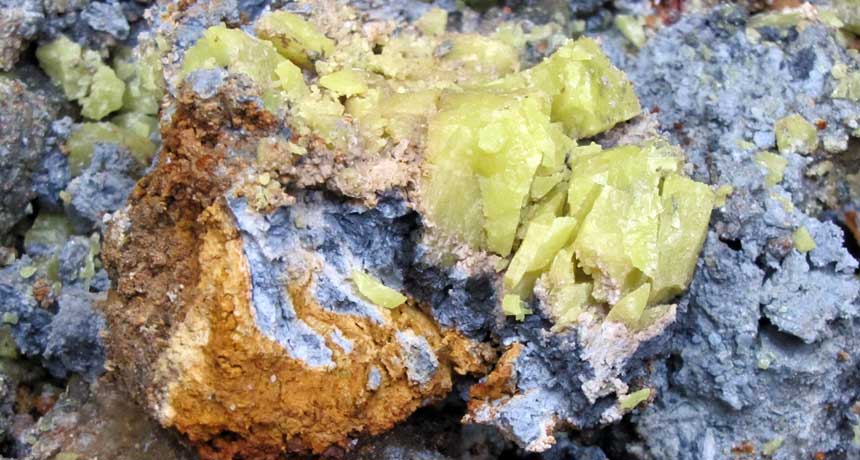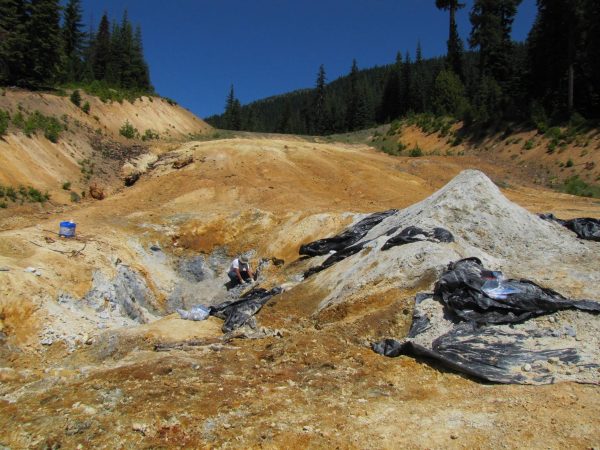Clay: A new way to fight germs?
Volcanic clays may one day offer a new way to fight infections

A nodule of Oregon blue clay used in tests for killing germs. It’s seen here coated with red clay and next to sulfur crystals coated in white clay.
Lynda Williams
Increasingly, doctors are finding that antibiotic drugs are not killing the infections they were meant to target. But a team of American geologists think a solution may be right under our feet: clay.
Many bacteria that make us sick are becoming resistant to antibiotic drugs. The germs’ genes have changed over several generations. And some of those changes have made the microbes immune to the medicines meant to kill them.
Clay, however, can kill these germs. But not just any clay will do, explains Lynda Williams. She’s a geologist at Arizona State University in Tempe. Clay that formed after the eruption of ancient volcanoes works best, she finds.
As water heated by a volcano moves through deposits of volcanic ash, it can change the chemistry of clay. And that can give that clay traits that are “important for healing,” Williams explains. Her team studied clay formed in association with volcanic ash deposits at a site near Crater Lake, Ore.
The geologists took samples from different areas at the site. The clay samples were each a different color: blue, white or red.
After drying each color of clay, the researchers mixed it with sterile water. Then they added either of two types of disease-causing bacteria: Escherichia coli (ESH-er-EESH-ee-ah KOHL-eye) or Staphylococcus epidermidis (STAF-ih-lo-KOK-us EP-ih-DER-mih-dis). The first germ can cause severe stomach cramps, diarrhea and vomiting. Some strains of it can even cause kidney failure and death. The second bacterium, S. epidermidis, causes skin infections

The next morning, the researchers removed each batch and added nutrients. If the bacteria were alive, they would eat the nutrients and grow.
The bacteria essentially laughed at the red clay. It had no effect on them, the researchers found. In contrast, all E. coli and S. epidermidis germs that had been incubated with the blue clay died. And the white clay: It had killed more than half of the E. coli and about 30 percent of the S. epidermidis.
Williams’ group describes its provocative findings in the August 1 Environmental Geochemistry and Health.
Too much of a good thing?
All three clays contained high levels of iron. Bacteria need this mineral to survive. But if they absorb too much, too quickly, it can kill them.
The red clay had been found near Earth’s surface. There, it had been in contact with oxygen in the air. This caused the iron in the clay to oxidize. When something oxidizes, it loses an electron, making the material very chemically reactive. Rust is an example of what oxidation can do to iron.
The white clay had been retrieved from underneath the red clay. Only some of its iron had oxidized. The blue clay, mined from underneath the other two clays, had been buried far from any contact with the air. Its iron had not oxidized at all.
Williams and her team discovered that oxidized iron behaves differently in the clay-water mix. That iron is less likely to leach out of the clay and into the water. That appears to have prevented the bacteria from picking up an overdose of it.
In contrast, bacteria mixed with the blue clay easily retrieved iron from the solution. “It’s like we are giving them too much chocolate cake,” says Williams. “It’s what they want, but it’s so much that it kills them.”
Bacteria are unlikely to become resistant to blue clay, she suspects. It simply releases its iron too quickly. Bacteria would not have enough time to evolve genes that might make them immune, she says.
Clay also may offer a new line of attack in fighting bacteria that have already become resistant to standard antibiotic medicines. Still, using clay to fight disease remains a long way off. One reason: Even if the clay does prove capable of killing many infectious bacteria, more tests will needed to see how much clay a sick patient might need or how doctors might need to administer it.
People in various parts of the world have used clay for a long time to cure illness, notes Warren Huff. A geologist, he works at the University of Cincinnati in Ohio.
As Williams’ research demonstrates, the challenge will be “finding the right clay,” says Huff. “Not all clays are the same, and it is critical to find just the right chemical composition in a clay that will make it an effective antibacterial agent.”
Williams agrees: “Natural products like clay vary in their chemistry from one shovelful to the next.” So, she cautions, it would not be safe to use any clay for this purpose unless it has first been tested and approved for medical use.
So is clay an ‘antibiotic’?
The first antibiotic, penicillin, came from a mold. From the 1920s to 1940s, chemists based the recipes for most new antibiotics on the natural poisons that molds and other microbes had made to protect themselves from bacteria. Over time, however, other synthetic agents — lab-created chemicals, some with no link to living organisms — emerged that also could kill or inhibit the growth of infectious bacteria. Today, many drug designers prefer to use the term ‘antimicrobial agent’ to refer to both natural and synthetic compounds. Still, “many people use the word ‘antibiotic’ to refer to both,” notes the U.S. Centers for Disease Control and Prevention.
Clays, as nothing but a collection of minerals, probably fit the antimicrobial definition better. But they certainly achieve the same function as antibiotic medicines, notes Williams.
Power Words
antibiotic A germ-killing substance prescribed as a medicine (or sometimes as a feed additive to promote the growth of livestock). It does not work against viruses.
antimicrobial A substance used to kill or inhibit the growth of microbes. This includes naturally derived chemicals, such as many antibiotic medicines. It also includes synthetic chemical products, such as triclosan and triclocarban. Manufacturers have added some antimicrobials — especially triclosan — to a range of sponges, soaps and other household products to deter the growth of germs.
bacterium (pluralbacteria) A single-celled organism forming one of the three domains of life. These dwell nearly everywhere on Earth, from the bottom of the sea to inside animals.
Centers for Disease Control and Prevention, orCDC An agency of the U.S. Department of Health and Human Services, CDC is charged with protecting public health and safety by working to control and prevent disease, injury and disabilities. It does this by investigating disease outbreaks, tracking exposures by Americans to infections and toxic chemicals, and regularly surveying diet and other habits among a representative cross-section of all Americans.
chemistry The field of science that deals with the composition, structure and properties of substances and how they interact with one another. Chemists use this knowledge to study unfamiliar substances, to reproduce large quantities of useful substances or to design and create new and useful substances.
clay Fine-grained particles of soil that stick together and can be molded when wet. When fired under intense heat, clay can become hard and brittle. That’s why it’s used to fashion pottery and bricks.
gene A segment of DNA that codes, or holds instructions, for producing a protein. Offspring inherit genes from their parents. Genes influence how an organism looks and behaves.
geology The study of Earth’s physical structure and substance, its history and the processes that act on it. People who work in this field are known as geologists.
immune Able to ward off a particular infection or show no impacts from a particular poison. More generally, the term may signal that something cannot be hurt by a particular drug, disease or chemical.
infection A disease that can be transmitted between organisms.
microbe Short formicroorganism. (see microorganism)
microorganism A living thing that is too small to see with the unaided eye, including bacteria, some fungi and many other organisms such as amoebas. Most consist of a single cell.
mineral The crystal-forming substances, such as quartz, apatite, or various carbonates, that make up rock. Most rocks contain several different minerals mish-mashed together. A mineral usually is solid and stable at room temperatures and has a specific formula, or recipe (with atoms occurring in certain proportions) and a specific crystalline structure (meaning that its atoms are organized in certain regular three-dimensional patterns).
nutrients Vitamins, minerals, fats, carbohydrates and proteins needed by organisms to live, and which are extracted through the diet.
oxidation A process that involves one molecule’s theft of an electron from another. The victim of that reaction is said to have been “reduced.” It can make itself whole again by robbing an electron from another molecule, triggering another case of oxidation. These chemical reactions are so violent, chemically, that they can easily kill cells. The oxidative reaction often involved oxygen atoms — but not always.
resistance (as in drug resistance) The reduction in the effectiveness of a drug to cure a disease, usually a microbial infection.
synthetic (as in materials) Materials created by people. Many have been developed to stand in for natural materials, such as synthetic rubber, synthetic diamond or a synthetic hormone. Some may even have the same chemical structure as the original.
volcano A place on Earth’s crust that opens, allowing magma and gases to spew out from the mantle. The magma rises through a system of pipes or channels, sometimes spending time in chambers where it bubbles with gas and undergoes chemical transformations. This plumbing system can become more complex over time. This can result in a change, over time, to the chemical composition of the lava as well. The surface around a volcano’s opening can grow into a mound or cone shape as successive eruptions send more lava onto the surface, where it cools into hard rock.







